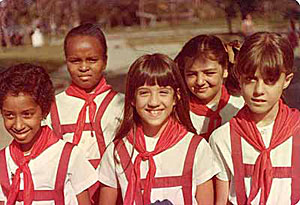Offside (Iran, director Jafar Panahi): Filmed during an actual qualifying match for the 2006 World Cup, Offside works brilliantly as both a comedy and a tragedy. The film follows the fortunes of a group of young women who are caught trying to sneak into a football match at Tehran’s Azadi Stadium. The country’s Islamic religious leaders have decreed that women may not sit with men at sporting events, lest they be exposed to cursing and other morally questionable behaviour. This hasn’t stopped the country’s young female fans, who continue to sneak in using various tricks. But Panahi focuses on a small group who have been caught and are being detained agonizingly close to the action. They beg the bored soldiers guarding them to let them go or at least to let them watch the match. The soldiers tell them they shouldn’t have tried to get in, that they could have watched the game at home on TV. They banter back and forth in almost real-time as the game continues, just off-camera.
There is one very funny sequence where a young soldier accompanies one of the girls to the restroom. Since there are no female restrooms at stadiums, he has to clear the room of any men before he can allow her to go in. Plus, he makes her cover her face so no one can see she’s a woman. This is accomplished using a poster of Iranian soccer star Ali Karimi as a mask, with eye holes punched out.
You get a real sense that even the soldiers are baffled by the prohibition, and are only carrying out their orders so as to hasten the end of their compulsory military service. One soldier complains that he was supposed to be on leave so he could take care of his family’s cattle in the countryside. Little by little, the girls and the soldiers talk to each other, and there are numerous small acts of kindness on both sides to show that these are basically good people living in terrible circumstances. However, the soldiers’ constant reminder that “the chief” is on his way lends a sense of menace, since we don’t know what sort of punishment the women will face.
Unlike most Iranian films, which are known for their strong visuals, Offside is filmed in a realist style with no artifice. In fact, the film was made during the actual qualifying match against Bahrain that took place on June 5, 2005. The “plot” in many ways was determined by the result on the pitch. If Iran won the match, they would qualify. If they lost, they would not. Since the World Cup has come and gone, I don’t think it is a spoiler to say that Iran won the match. The scenes of celebration at the end of the film were real and spontaneous, which gave the film a real authenticity. Seeing how much this meant to the people of Iran was deeply touching.
As well, one of the young women makes reference at the end of the film to seven fans who died during the Iran-Japan match on March 25, just a few weeks before. They were trampled to death after police began to spray the crowd with water to move them in a certain direction. Knowing that this was a real-life tragedy added another level of poignancy to the celebrations.
I don’t want to go off on a long political tangent, but this film gave me real hope that there are those in Iran who are hoping for change and working at it. Iran is a nation of young people, and it is only a matter of time before they take the place of their elders in the political sphere. Films like this one show the proud spirit of the Iranian people in spite of their present difficulties, and it’s my sincere hope that there is a brighter future for them.
Interview with director Jafar Panahi
Good review from Sight and Sound magazine
 (9/10)
(9/10)


 (6/10)
(6/10)
 (7/10)
(7/10)
 (9/10)
(9/10)